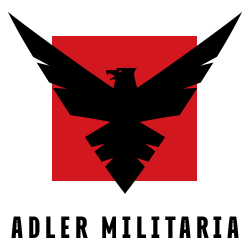Showing 55–63 of 1339 resultsSorted by latest
-
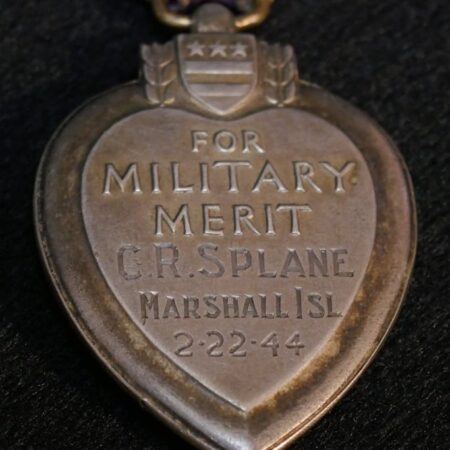
Original WWII Purple Heart – Pfc C R Splane – USMCR – Battle of Enewetak Atoll – Wounded in Action
Here we have a nice Purple Heart with what seems to be a private engraving. After researching it, it would seem he was wounded in the Battle of Enewetak Atoll. Charles R Splane from Nevada Member of the 22nd Marine Regiment. Marshall Islands: Battle of Eniwetok (22nd Marines: Navy Unit Commendation, February 17 to 22, 1944) On February 18, 1944, the 22nd Marines under the command of Colonel John T. Walker, participated in the Battle of Eniwetok, in the northwest area of the Marshall Islands, capturing the islands of Engebi in 6 hours, Eniwetok Atoll on February 21 with the 1st and 3rd Battalions of the 106th Infantry Regiment of the 27th Infantry Division, and Parry on February 22. The 22nd Marine proceeded to take Kwajalein and Roi-Namur from March 7 to April 5. This was the first Marine Corps unit to formally employ fire team tactics in combat. On April 6, the Marine regiment was sent to Guadalcanal for rest, replacements, and further training. I found more information here: https://genealogytrails.com/nev/state/ww2navyhonor.html https://en.wikipedia.org/wiki/22nd_Marine_Regiment https://www.history.navy.mil/content/history/museums/nmusn/explore/photography/wwii/wwii-pacific/gilbert-marshall-islands-campaign/invasion-marshall-islands.html
-

Oil Painting by Ernst Frommhold – “Feldbergblick” – Famous Third Reich Artist – Reichsführung SS – Deutsche Kunst 1944
$995.00Here we have a rather odd item for a change! Feldbergblick by Ernst Frommhold Ernst Frommhold (* November 17, 1879 in Leipzig; † June 24, 1955 in Leipzig) was a well-known German landscape and marine painter. Ernst Frommhold came from a farming family living in the Leipzig area. After completing school, he was not allowed to study painting at the Leipzig Art Academy, as he had chosen to do, but instead had to complete an apprenticeship as a merchant and eventually became self-employed in this field. He continued the artistic pursuits he had devoted himself to since childhood in his free time. Numerous study trips took him to Italy, Switzerland, and twice on a steamship across the North Sea to the coast of Iceland. After the inflation following the First World War, he gave up his business and made his living exclusively from painting. In order to gain the necessary professional recognition, he planned to study at the Academy in Leipzig after all. There, however, he is said to have received a warning from Professor Hey that he could no longer teach him anything new and that Frommhold should simply continue as before. Frommhold was represented with six paintings at the Great German Art Exhibition in Munich in 1937, 1938, 1939, and 1940. Of these, “In the Heart of Greater Germany” was purchased by Emil Georg von Stauß, General Director of the Deutsche Bank, in 1939, and “Fertile Land” was purchased by the Reich SS leadership in 1940. In 1951, the artist moved to Karlsruhe, where he drew particular inspiration from the neighboring Black Forest in his final years. Having just recovered from a heart condition, he died unexpectedly in 1955. More information about his paintings during the TR. https://www.gdk-research.de/db/apsisa.dll/ete Price includes shipping and handling.
-
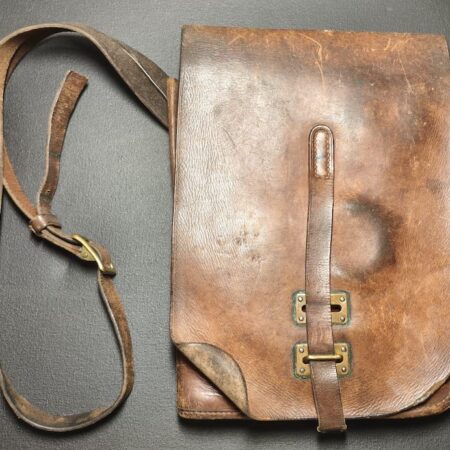
Original WWII Soviet Officers Map Case with Cross Strap – Lend-Lease – US Made – Rare
$285.00Here is a rather rare find, this is a Soviet WWII Lend-Lease US made Officers Map Case. You can see that the case is in quite good condition, the leather is still fine and great for display. There was at some period a Soviet Compass inside the imprint can be seen.
-
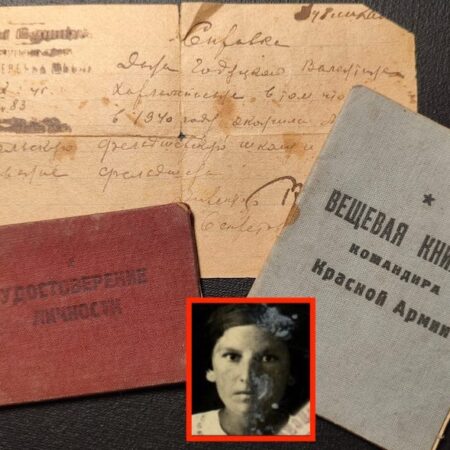
Original WWII Soviet Red Army Female Medical Officers Identity Papers – Senior Lieutenant Gadyatskaya – 137th Infantry Division RKKA – Archive Research / Photo – Rare!
$175.00Here we have a really odd find, that not often comes to the market. This set belonged to: Senior Lieutenant of the Medical Service – Valentina Gadyatskaya She served in a Military hospital and even was awarded the “Medal for Military Merit” she was still alive in the early 1990s as she was awarded the Veterans editions of the “Order of the Patriotic War 2nd Degree”. Her full information can be seen in the Red Army Online Archive, including her photo. Date of birth __.__.1922 ; 25.12.1921 Place of birth Ukrainian SSR, Donetsk region, city of Zhdanov ; Ukrainian SSR, Stalin region, city of Mariupol Place of conscription Mariupol State Military Commissariat, Ukrainian SSR, Stalin region, Mariupol Date of conscription 22.06.1941 Military rank Senior lieutenant of the medical service ; Senior lieutenant of the medical service Military unit 137th Infantry Division Awards Medal “For Military Merit” Order of the Patriotic War, 2nd degree Link to information: https://pamyat-naroda.ru/heroes/person-hero92516846/?backurl=%2Fheroes%2F%3Fadv_search%3Dy%26last_name%3D%D0%93%D0%BE%D0%B4%D1%8F%D1%86%D0%BA%D0%B0%D1%8F%26first_name%3D%D0%92%D0%B0%D0%BB%D0%B5%D0%BD%D1%82%D0%B8%D0%BD%D0%B0%26middle_name%3D%26date_birth_from%3D%26static_hash%3D17f71efbce3ede81709ecada02fbffd5b3573f3600cdbc1aa8742bd494516397v1%26group%3Dall%26types%3Dpamyat_commander%3Anagrady_nagrad_doc%3Anagrady_uchet_kartoteka%3Anagrady_ubilein_kartoteka%3Apdv_kart_in%3Apdv_kart_in_inostranec%3Apamyat_voenkomat%3Apotery_vpp%3Apamyat_zsp_parts%3Akld_ran%3Akld_bolezn%3Akld_card%3Akld_upk%3Akld_vmf%3Akld_partizan%3Apotery_doneseniya_o_poteryah%3Apotery_gospitali%3Apotery_utochenie_poter%3Apotery_spiski_zahoroneniy%3Apotery_voennoplen%3Apotery_iskluchenie_iz_spiskov%3Apotery_kartoteki%3Apotery_rvk_extra%3Apotery_isp_extra%3Asame_doroga%3Asame_rvk%3Asame_guk%3Apotery_knigi_pamyati%26page%3D1%26grouppersons%3D1&
-
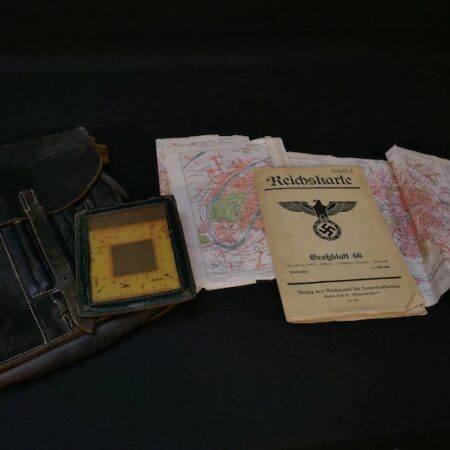
Original WWII German Army Map Case With Contents – Map Frankfurt Oder / Küstrin – Map Paris – Pencil – WaA Ruler
$375.00Here we have a very nice set as found, German Officers Map case with the contents. We decided to leave it as is, inside is a Map of Frankfurt (Oder) – Seelow Battle Area, Maps of the city of Paris and a very nice and quite rare Wehrmacht WaA Marked Ruler and pencil.
-
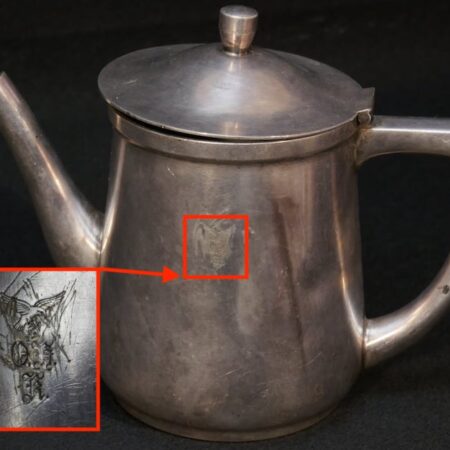
Original WWII German Luftwaffe Silver – 1.L Tea Pot – Luftwaffe Offiziersheim Kaufbeuren – Fliegerhorst Kaufbeuren- Rare
$385.00Here we have a really nice Luftwaffe Officers Mess item, marked with O.H.K – for Offiziersheim Kaufbeuren. This was found in Ireland in 2024, likely a British Army bring back after WWII The Swastica and Luftwaffe Adler has taken some beating, although this could be polished out to some extent/restored as I have been told. The maker of this item is: Württembergische Metallwarenfabrik, in Geislingen and der Steige. History of the area: In 1934, the city of Kaufbeuren sold the property on Apfeltrangerstraße to the German Reich. It was previously home to the “Tänzelhölzle,” a small wooded area with the Tänzelfest dance floor and labyrinth. Construction began in 1934, and the Reich Labor Service was among those involved. The first recruits were officially welcomed by Mayor Hans Wildung and other city dignitaries on October 29, 1935. The first permanent personnel of the newly established Kaufbeuren Aviation Training Center arrived at the facility on September 16, 1935. The first commander of an aviation replacement unit was Karl David (Karl Deinhardt from 1938 onward), who had been promoted to lieutenant colonel just a few weeks earlier. From October 1, 1936, the 25th Air Replacement Detachment was stationed there, which became the 23rd Air Replacement Detachment on November 1, 1938, both under Deinhardt’s command. On April 1, 1939, the 23rd Air Training Regiment was formed, consisting of the 1st Training Battalion of the 23rd Air Replacement Detachment and the Kaufbeuren Pilot Training School. International training was provided at Kaufbeuren Air Base during the pre-war period: in 1938, Spaniards and Romanians were stationed there, and in 1939, Bulgarians were still there for training. In addition to the training unit, an air base company was stationed at the air base for guarding, ground defense, anti-aircraft defense, and supplying the air forces. In November 1939, the air training unit and the pilot training school were relocated. The training battalion was relocated to Döberitz-Elsgrund, the pilot training school to Jüterbog-Damm, and a transport unit was stationed at the air base instead. From May 1940 until the end of the war, the pilot training school was stationed in Kaufbeuren again. The pilot training battalion returned to Kaufbeuren in June 1940 and was relocated to Belfort and Montbéliard in the summer of 1942. It was succeeded by a replacement battalion, which was responsible for replenishing the Afrika Korps’ material and personnel. At the same time, soldiers from the North African front came to Kaufbeuren for recuperation. From April to June 1942, Liaison Squadron 62, which had been disbanded in November 1941, was reorganized in Kaufbeuren and flew to the southern Russian front on June 14, 1942. From August to October 1944, III./KG 26 (III. Group of Kampfgeschwader 26) was stationed here. The air base was marked on Allied air force maps, but was only listed as a backup target throughout the war and, along with the town of Kaufbeuren, was spared major air raids. Air surveillance was controlled from the “Skihütte” in Oberbeuren, about one kilometer away. The air reporting and analysis center was located in the building, elevated on a slope. This center was designed to warn the air base crew of approaching enemy aircraft. In this case, the air base was evacuated, and the ski hut was used as the command post for the commanding officers. End of the War and Takeover by the US Air Force The pilot training school was officially disbanded on April 2, 1945, and a combat battalion was formed from the remaining soldiers. On the morning of April 27, 1945, the air base was completely evacuated. The American ground troops found the air base deserted but largely intact. After the Second World War, the Advanced Landing Ground (ALG R-70), as it was originally designated by the Allies after being occupied by the Americans, was used as “Kaufbeuren Air Base” by the United States Army Air Forces (from 1947 the United States Air Force). The facility was handed over to the Federal Republic of Germany on December 14, 1957, and continued to be used as an air base for the newly formed Bundeswehr.
-
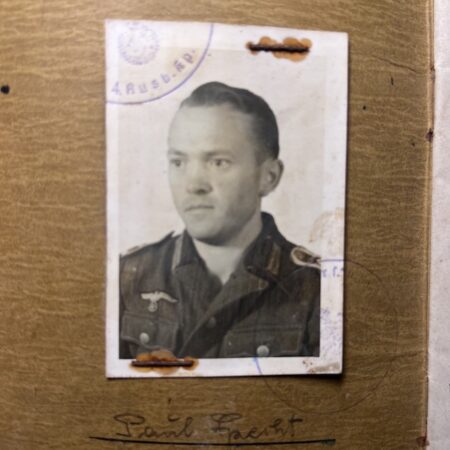
Original WWII German Soldbuch – Feldwebel Paul Specht – Panzer Grenadier Regiment 26 – 24 Panzer Division – Heiligenbeil 1945 – Rare
Soldbuch to Feldwebel Paul Specht It seems his Soldbuch was issued as a replacement with: Panzer Ersatz und Ausbildungs Abteilung 10 in September of 1944. Specht spent time in Litzmanstadt (Lodz) in 1944, with: Panzer Grenadier Ersatz Batl 413, and it seems they went into action there January 1945 and were almost wiped out. https://www.lexikon-der-wehrmacht.de/Gliederungen/InfErsBat/InfErsBat413-R.htm Specht was finally mobilised and sent via Marschbataillon Pz.Tr./307 to the 24. Panzer-Division, (Strength 300 Mann 4.1.1945 Wehrkreis X) Specht was assigned to his frontline unit of the 24 Pz Div – Panzer Grenadier Regiment 26 – 1 Schwadron Commanded by: Major Höhne (RK,DKIG) Killed in Action – February 19th, 1945 (Zinten, Heiligenbeil/Eastprussia, Germany) His Profile: https://www.tracesofwar.com/persons/6832/H%C3%B6hne-Georg.htm The division was then transported by rail, leaving behind its heavy weapons and armored vehicles, to Marienburg/Elbing (East Prussia). In the Elbing area, it was provisionally re-equipped with weapons and vehicles. The division was then deployed for defense and counterattacks in Southeast Prussia. From February 21 to March 27, 1945, defensive fighting followed in Ermland and the division withdrew to the bridgehead near Heiligenbeil. At the end of March 1945, the division was transported across the Baltic Sea to the Vistula Spit near Pillau. In mid-April, the remnants of the division (approximately 4,000 to 5,000 soldiers) were evacuated to Schleswig-Holstein, where it surrendered. Interesting Equipment: Peaked Visor Cap, Camo Kit Medals/Awards: Shooting Lanyard, 1st Class – 22.7.1941, Sports Badge in Bronze – 31.7.1941, War Merit Cross with Swords 20.4.1943. Fate: I have checked online resources and was not able to find what happened to Specht, although it could be that he made it back to Germany and surrendered, although there is no POW markings on the Soldbuch, a mystery that may later be solved…
-
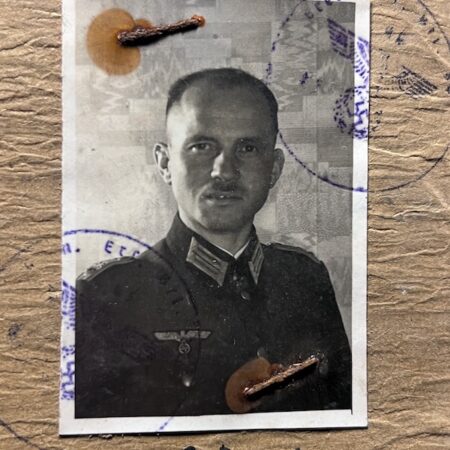
Original WWII German Soldbuch – Oberleutnant Ringel – Italy Milan 1943 – Grenadier Regiment 216 – 102 Inf Div – Iron Cross First Class – Escaped Pillau 1945 – POW Western Front! – Rare
Soldbuch issued in 1941 to Stone Mason Master from the area of Braunau (CZ), Arno Ringel. Frontline Units: Landesschützen Batl 554 The Landesschützen Battalion IV/VIII was established during mobilization on August 26, 1939, in Görlitz, in Wehrkreis VIII. The battalion was formed from the Infantry Replacement Battalion 406. The battalion was apparently deployed to Reichenbach during the winter of 1939/40. On April 1, 1940, the battalion was renamed Landesschützen Battalion 554. The battalion was subordinated to Division z.b.V. 408. From there, the battalion was deployed to the Commander of the VIII Prisoners of War. Feldkommandantur 1013 Field Command 1013 was established on August 22, 1943, in Military District VIII. Subsequently, the staff was subordinate to the General Staff of the 14th Army and then to the Plenipotentiary General of Italy and was located in Milan. Regiments Gruppe 348 – (102 Infanterie Division) Wounded in May 1944 – Bullet wound!! Interestingly the unit is mentioned here: https://www.lexikon-der-wehrmacht.de/Gliederungen/Divisionsgruppe/DivGruppe216.htm Field Post Numbers: The units (Staff, Regimental Groups, and 14th Company) were all registered in the field post overview as parts of Divisional Group 216 from January 10, 1944. The 13th Company followed on March 22, 1944. The 13th and 14th Companies were then assigned to Regimental Group 348 from May 22, 1944. The regimental groups and the staff were renamed parts of Grenadier Regiment 216 between November 23 and 29, 1944. Grenadier Regiment 216 ( 216 Infanterie Division) – Seems this was his last unit. From August onward, the division continued its retreat across the Lessna, the Bug, and the Narew Rivers to the East Prussian defensive position until January 1945. At the end of 1944, Division Group 216 was renamed Grenadier Regiment 216. After the costly battle for East Prussia, the remnants of the division withdrew via Sensburg and Heilsberg to the Königsberg area. The division was finally smashed in the Rosenberg-Balga-Heiligenbeil pocket. Remnants managed to escape across the Frisches Haff to Pillau. These remnants continued fighting in Western Pomerania as Division Group 102, surrendering to the Americans at Trave on May 5, 1945. Awards: War Merit Cross with Swords, Second Class, Jan, 1944, April 1944 – Iron Cross Second Class and Wounds Badge in Black, February 1945 – Iron Cross First Class – 102 Infanterie Division. He seemed to have defaced the Nazi Symbol on the entry with a smoke. Equipment: P38 Pistol, Compass, Lamp Diverse Paperwork Included: Drivers Licence, Permit to Drive in Milan Italy with his own car. Entry for bottle of Sparking wine, and Führer Present in Hospital June 1944. Border Crossing Permit to Denmark in 1943 on his way to Copenhagen in May of 1943! A POW Paper Issued by the Military Government of France. Condition: Missing Pages 5 – 7 – Addresses , not really critical on this one as not much information was lost, its possible he used it to prove his residence for Repatriation in June 1945 (See below) Final Comments It seems that Ringel was an experienced and battle-hardened Officer, he was awarded the Iron Cross First Class in February of 1945, and he managed to escape the hell in Eastern Prussia (likely only with some sort of boat!) Making it back to the Western Front he was by June of 1945 he was in a French POW Camp, mentioned in pencil is that he was repatriated by the American XXII Corps to return to the former occupied region of the Czech Republic, where he was from. Overall this is a desirable Soldbuch of a frontline Officer who survived the Western and Eastern Fronts.
-
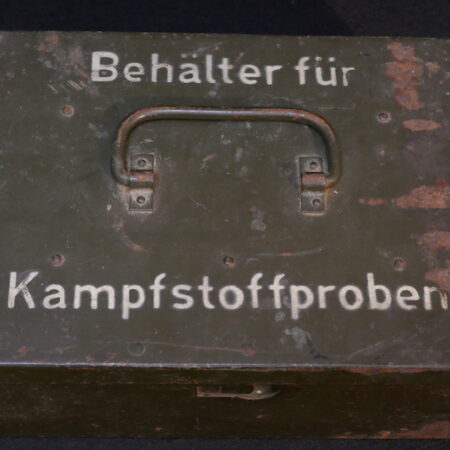
Original WWII German Army Wehrmacht Box for – Behälter für Kampfstoffproben -Chemical warfare samples – Rare
$165.00Interesting box here for Chemical warfare samples.
